![]()
Normandy Revisited
- or: The Story of the Toughness of Old Army Vehicles... 
By Kim Frost Fuglsang
This is the story of an old GPW Jeep from 1944 being driven all the way to Normandy from southern England and how it put new limits on what an old vehicle can do and how a new and modern vehicle would immediately surrender under similar conditions. Maybe there's also the little morale that the simple and transparent structures with more than 60 year on its back, would beat any of today's complex and sophisticated constructs and designs .... At least that is the way we like to see it. All constructors of modern military vehicles should live by the motto: "KISS", the abreviation of: "Keep It Simple Stupid" .....
 Who will not agree with me that some of the most fun is to play with old green military vehicles. It's not only fun but also pretty cool we all think. We find the child within ourselves and with great pleasure spend many hours of our scarce free time to repair and maintain these old vehicles ... But the question is how many people really think about how cool the vehicles actual is .. I am thinking most of what the old vehicles, often with an advanced age of over 60 years, may perform under the most unimaginable conditions. There is no doubt that from the constructors' side there has been a primary focus on strength, functionality and simplicity. But anyway, I make the assertion that even the most optimistic of all the designers from time to time would lose the lower jaw when they saw what the various old vehicles could carry - strictly against all technical odds. Who will not agree with me that some of the most fun is to play with old green military vehicles. It's not only fun but also pretty cool we all think. We find the child within ourselves and with great pleasure spend many hours of our scarce free time to repair and maintain these old vehicles ... But the question is how many people really think about how cool the vehicles actual is .. I am thinking most of what the old vehicles, often with an advanced age of over 60 years, may perform under the most unimaginable conditions. There is no doubt that from the constructors' side there has been a primary focus on strength, functionality and simplicity. But anyway, I make the assertion that even the most optimistic of all the designers from time to time would lose the lower jaw when they saw what the various old vehicles could carry - strictly against all technical odds.
Who has not heard the remark: "with a piece of wire, a little scotch tape and an old screwdriver, you can repair a Jeep´s “Go Devil” engine anytime. As a good comparison of the importance of simple constructions for field use, was how the Allied forces repaired a great number of vehicles in different workshops during the different war campaigns in order to put them back in to service, where the Germans had to leave many vehicles as they were either in need of spare parts and some of the constructions were simply to sophisticated to repair in the field. That made the need for efficient and continuing supplies crucial.
Well ... now back to the story of an old Jeeps hardships on its way to Normandy.
Departure

We were a small team of happy and excited "boys" who after 5 years of planning and savings, finally were about to leave for the coasts of Normandy. The occasion was 65 years for the D-Day invasion. For most of us, this was not the first trip and yet we all had great expectations for 14 days "in the field with the boys" ...Participating vehicles in our expedition would be:2 Jeeps, one 3 axle Dodge WC62 and a "short" Dodge. Furthermore a rare Chevrolet C8a HUP and a GMC truck. All vehicles with passengers, being friends, fathers and uncles.
Never had our vehicles been so prepared this time. Oil change, moving parts lubricated, greasy and checked well adjusted and repaired to a great extend. Having learned from previous trips, we knew exactly what was in store from our "brothers in arms" from around the world so all vehicles should therefore also be totally “pepped up” and had been thorugh a good game of "shining" in the form of paint, markers, etc. We all felt that we were poised to take off in our beautiful vehicles without the risk of accident or technical problems. We were more than ready to go to Normandy.
The trip would start in Copenhagen, Denmark (for anyone concerned even all the way from Bornholm) and would take us across Denmark to the West Coast of Denmark, Esbjerg. From Esbjerg we would sail to England to gather with our English club friends, and all together sailing from Portsmouth (same starting point for the Allied forces during D-Day) to Quistreham on the West coast of France, almost in the heart of Normandy. We would therefore “invade France from the right side!
We set off from Copenhagen with our fully-packed vehicles in high sunshine and nice weather. The first stage from Copenhagen to Middelfart, in the middle of Denmark, went very well without any technical problems and there was no doubt that it was very good for the engines to “stretch legs” go for a long and steady drive.
The trouble begins ...
After a short stop in Middelfart, my engine suddenly began to put out a little as if there were impurities in the gasoline ... "Strange" - I thought .. I had just changed the fuel filter! Well, it was only in the short term "attack" and I were able to keep it running.
We continued with 50 m.p.h. towards Esbjerg without stopping, and although it sputtered a little sometimes, it went amazingly well and I decided to wait to check the engine until after arrival in Esbjerg. Good 30-40 km before Esbjerg the engine spurred like a dream and there were no problems or booze so I thought now what might have been “sitting on the cross", had been flushed through the system and the problem was over. We arrived in Esbjerg safely and we decided to start doing the last packing of our vehicles and finished with our tents and all sorts equipment. There was not so much as an inch to spare on the vehicles .. We were ready to "go to war” and I had forgotten all about the problems with my engine. We made us hopeful for the night, but not after a game of local fish, some cold beers from the cooler. The spirit was high and nothing could stop us now.
Next morning went with the last initializations and embarkation on board the ferry ... No problems. Well onboard time passed with dinner, a little fun at the bar and the usual tall tales - and then to bed so we could be ready for next day driving through the southern part of England in the “wrong side of the road” from Harwich to Portsmouth.
Next day - scheduled arrival at Harwich and all vehicles began all together to move south to Portsmouth where we would spend the night before the big crossing to Quistreham next morning. There was a high sun and very good driving conditions so everyone was happy. All vehicles chugged along with the Chevrolet as our "Tail End Charlies". Still no technical problems, I had no reason to tinker in the engine during our brief stop at various staging areas.
A few hours went by "high" speed and smooth pull southward. The only minor technical issue was the accelerator feature of the Chevrolet, which Paul, the driver, had great trouble with. For each stop, we were inside and move around a bit on some auxiliary springs and little did it help until we found out that the accelerator rod hatched on the engine block ... This prompted us resolving the problem so that Paul was pleased to manage acceleration little better, just about 0-70 kmh in 130 seconds . Perfect!
Another Hiccup ...
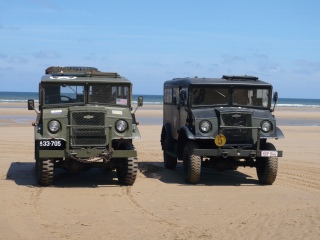 Then suddenly, "damn take me," began my Jeep suddenly to chop and crackle again .... "Damn" I thought while the blood pressure went up ... By immediately pressing the clutch in and revving strongly I could get normalized traction during shipping, but I was not quite steady. Something was wrong. Could it be a blockage in the carburetor? Well, we went and I tried as best I could to keep the vehicle running and of course it was somewhat easier if it was in service as long as I switched off when it began to cough. I was beginning to prepare myself to having to remove the carburetor to clean it when we came to the camp in Normandy, or maybe Portsmouth ... So, it could just keep running the last 250 km, and then for us to board the ferry in Portsmouth .... so I should have plenty of time and easy access to spare parts from our friends at Wildenberg, who would be in Normandy as always with tons of spareparts. With the adrenalin thumping and a growing irritation, I could detect that the engine started to crackle more frequent, but we were obliged to continue as we found ourselves on a busy highway with lots of angry traffic. I had communicated with the other vehicles that I had some problems with the engine, but chose to continue. It was worst driving uphill and I thought it might be the "High Speed" nozzle that was the problem! Then suddenly, "damn take me," began my Jeep suddenly to chop and crackle again .... "Damn" I thought while the blood pressure went up ... By immediately pressing the clutch in and revving strongly I could get normalized traction during shipping, but I was not quite steady. Something was wrong. Could it be a blockage in the carburetor? Well, we went and I tried as best I could to keep the vehicle running and of course it was somewhat easier if it was in service as long as I switched off when it began to cough. I was beginning to prepare myself to having to remove the carburetor to clean it when we came to the camp in Normandy, or maybe Portsmouth ... So, it could just keep running the last 250 km, and then for us to board the ferry in Portsmouth .... so I should have plenty of time and easy access to spare parts from our friends at Wildenberg, who would be in Normandy as always with tons of spareparts. With the adrenalin thumping and a growing irritation, I could detect that the engine started to crackle more frequent, but we were obliged to continue as we found ourselves on a busy highway with lots of angry traffic. I had communicated with the other vehicles that I had some problems with the engine, but chose to continue. It was worst driving uphill and I thought it might be the "High Speed" nozzle that was the problem!
Third hic ...
We were still rolling, and when not spluttered and sat out, it drove actually quite excellent ...... BUT then it began to sputter completely aggressive and put more out than run cleanly. I could only keep it going at idle .... no traction, but the engine was not dead. It remained still in progress and I could just "limp" along, but still under its own power.
 I immediately sent a "Mayday" to all vehicles and agreed that we should meet at the next rest area ..... I had to pull out in the dirt and otherwise hobble up to the nearest rest area ahead ..... It still ran, but there was not much traction back ...After some distance, I could finally hobble into the rest area where all the others were lined up and waiting for us .... Up with the hood to check the fuel pump, fuel lines, spark plugs (which were well blackened by soot) .. Lots of fuel supply, but no spark. We had found a set of new spark plugs and checked the ignition wether it had moved. We were also checking each spark plug ... something was wrong. Checking the Condensator and sinkers ..... and oups ..!!! Here was the problem ... The sinkers had split in two and had shifted so that the “contact surface” was only 10-15%. So consequently no sufficient spark through the spark plugs. Forward with a new set of sinkers that was some of the mandatory spareparts we had brought with us.. customizing them and then first attempt to start 20 minutes later. It now purred like a kitten, or should I say a “roaring tiger” ... I immediately sent a "Mayday" to all vehicles and agreed that we should meet at the next rest area ..... I had to pull out in the dirt and otherwise hobble up to the nearest rest area ahead ..... It still ran, but there was not much traction back ...After some distance, I could finally hobble into the rest area where all the others were lined up and waiting for us .... Up with the hood to check the fuel pump, fuel lines, spark plugs (which were well blackened by soot) .. Lots of fuel supply, but no spark. We had found a set of new spark plugs and checked the ignition wether it had moved. We were also checking each spark plug ... something was wrong. Checking the Condensator and sinkers ..... and oups ..!!! Here was the problem ... The sinkers had split in two and had shifted so that the “contact surface” was only 10-15%. So consequently no sufficient spark through the spark plugs. Forward with a new set of sinkers that was some of the mandatory spareparts we had brought with us.. customizing them and then first attempt to start 20 minutes later. It now purred like a kitten, or should I say a “roaring tiger” ...
Incredibly, all the way from Middelfart to the the north of Portsmouth, I had been running with a broken set of sinkers and gradually more and more sooty spark plugs .. though it had still been moving under its own power until I finally let go of the accelerator at the rest area near Portsmouth ..... unbelievably tough.
No more hiccups ...
After a nice drive with lots of traction, we were finally in Portsmouth and the vehicles were parked for the night and went out and ate pizza in was appeared to be the only restaurant open at that late time of the night.
Next morning, very early, we drove down to the ferry where a larger group of British military vehicles, maybe a couple of hundred vintage military vehicles were about to line up for the crossing to Quistreham. The crossing was used by us all to relax and mentally get ready for the “Landing in Normandy”.
Finally Normandy

After a successful crossing to Normandy, we were now on shore and started the drive towards our camp site in Asnelles, in the British Sector, via the coastal road. The weather was good and we had great expectations. After some driving through narrow pictoresque villages, we arrived at the camp. We found us a nice corner at the camp site and startet setting up our dining tent followed by our individual tents and then finally parking our vehicles. Our French neighbors at the campsite looked anxiously at our doings and activities .... but we immediately built a cultural bridge when we offered the gentleman in the caravan a box of Danish Ceres Royal beers, while his wife secretly peeped out through the curtain of the awning. Neighborly friendship was secured and we could continue our camp building, accompanied by Glenn Miller on the field radio and high spirits.
 During the following days, we carried out some pretty amazing trips to all the famous places. After experiencing the American cemetery at Omaha Beach, we were also down on the beaches below the cemetery known from the beginning of the movie "Private Ryan". Close to our camp we visited Arromance where we again had to enter and experience the Mulberry museum as through beautiful models showing the artificial harbor, which had a flow of supplies once the Allies had gained a foothold on the mainland. The harbor was unfortunately destroyed by a severe storm and even today one can still see several of the large caissons off the coast. During the following days, we carried out some pretty amazing trips to all the famous places. After experiencing the American cemetery at Omaha Beach, we were also down on the beaches below the cemetery known from the beginning of the movie "Private Ryan". Close to our camp we visited Arromance where we again had to enter and experience the Mulberry museum as through beautiful models showing the artificial harbor, which had a flow of supplies once the Allies had gained a foothold on the mainland. The harbor was unfortunately destroyed by a severe storm and even today one can still see several of the large caissons off the coast.
The traditional omelet and Leffy beer in the cozy little town, Creully, where Montgommery had his headquarter, was captured several times and this in the beautiful sunshine on the square in front of the church.
In far greater extent than previous trips, we had on this trip an opportunity to meet and talk with old veterans from both the U.S., but especially from British units. Always a very touching experience to talk to the real veterans who really had been there when it all broke loose. As something new, we visited the excavated bunker at Maisy, which was found by a British amateur archaeologist by the use of an old military map of the beaches. Exciting experience.
In the evening on June 5, there was a gigantic fireworks all along the beach together and with lots of bang, bang. Fantastic! For those of us who had decided to lie us up in the camp in our tents, it was like being there in 1944 ... a deafening noise and booming sound in the diaphragm.
D-Day
 On June 6th, D-Day, we were all getting up at. 5:00 to join the On June 6th, D-Day, we were all getting up at. 5:00 to join the 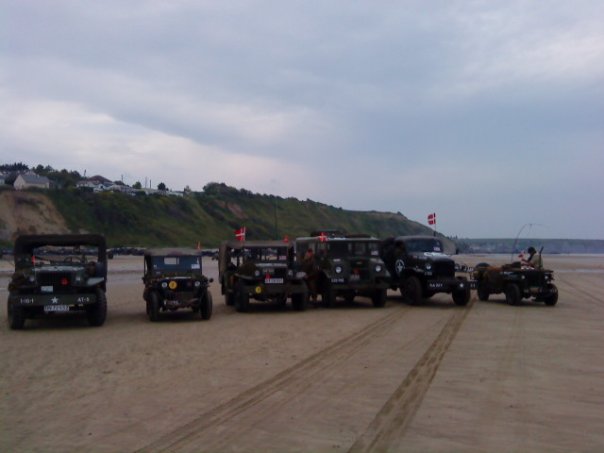 English club's memorial service at SWORD beach below our camp. Wreaths laying ceremony and a minute's silence exactly at the time when the British troops went ashore. Very touching. English club's memorial service at SWORD beach below our camp. Wreaths laying ceremony and a minute's silence exactly at the time when the British troops went ashore. Very touching.
Later we attended a large motorcade driving on the beach from Asnelles to Arromance where all the vehicles and thousands of happy visitors, both on beaches and on the square in front of the Mulburrey museum, had gathered, while the BBC was broadcasting directy with attending veterans. Here was a great atmosphere and everyone had taken pains to mark this day in a stylish and tasteful way.
The evening meal was consumed at a nice cafe next to the camp and to an English memorial, where we in the finest style and in good company with a collection of the Belgian club's members, including their leader, Monsieur Vitmeur, ... marked this historic day - 65 years for Operation Overlord.
Memorial for 800 Danish seamen in Allied service
 We had prior to departure from Denmark, decided to lay a wreath at the memorial for Danish seamen in Allied service, including the actual D-Day. All Seaman participated on the sides of the Allies in spite of Denmark not being officially fighting the Germans.The monument is located quite close to the Utah Beach and we decided to visit our friend Erik, who is living in Normandy with his wife. After visiting his beautiful home, still with marks and bullet holes in the brick work from the fighting, we decided to take a drive around the area and visit “Dead Mans Corner”, well know from “Band of Brothers”. After our trip around we went to the monument to place the wreath and have a short ceremony. After our little ceremony, we went out to Utah beach where we again took a light lunch. Afterwards, we went by circuitous routes to St. Mere Eglise The place was full of visitors and US soldiers, so we decided to quickly run back to camp and away from the tourist inferno and the congestion in order to avoid being cramped in the traffic later on. Back in our camp we were all tired of all the driving and all tucked in after a quick evening meal. We had prior to departure from Denmark, decided to lay a wreath at the memorial for Danish seamen in Allied service, including the actual D-Day. All Seaman participated on the sides of the Allies in spite of Denmark not being officially fighting the Germans.The monument is located quite close to the Utah Beach and we decided to visit our friend Erik, who is living in Normandy with his wife. After visiting his beautiful home, still with marks and bullet holes in the brick work from the fighting, we decided to take a drive around the area and visit “Dead Mans Corner”, well know from “Band of Brothers”. After our trip around we went to the monument to place the wreath and have a short ceremony. After our little ceremony, we went out to Utah beach where we again took a light lunch. Afterwards, we went by circuitous routes to St. Mere Eglise The place was full of visitors and US soldiers, so we decided to quickly run back to camp and away from the tourist inferno and the congestion in order to avoid being cramped in the traffic later on. Back in our camp we were all tired of all the driving and all tucked in after a quick evening meal.
Next day, we went to the Pegasus bridge, described in other article. No visit to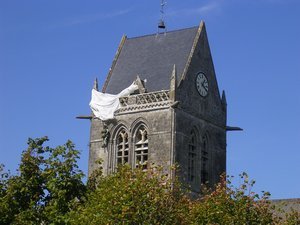 the bridge without “enjoying” a cup of the bridge without “enjoying” a cup of lukewarm and very expensive coffee at Cafe Gondre right beside the new and larger bridge. The coffee was brewed and served by none other than Madame Gondre, the daughter of the original owner and incidentally very same daughter who had been sitting on the lap of Major Howard after the British forces had secured the bridge in 1944. lukewarm and very expensive coffee at Cafe Gondre right beside the new and larger bridge. The coffee was brewed and served by none other than Madame Gondre, the daughter of the original owner and incidentally very same daughter who had been sitting on the lap of Major Howard after the British forces had secured the bridge in 1944.
The relative new Pegasus museum was a good experience and we had again an opportunity to have a talk with the many veterans in their dark blue suits with decorations and their distinctive maroon berets with the wing and parachute on. After some time at the museum where we saw a 1:1 replica of a Horsa glider and the original bridge displayed, we went to the Merville battery, not far from Pegasus, who was also an unexpectedly positive experience. On the way out to the Merville battery we went through the worst rain storms in living memory ... like Tom Hanks in "Forest Gump" could tell from his time in Vietnam, we saw that the rain coming in from both sides, from below, from above and behind ... so it was good that we could quickly find the old German rain cover and put them on in the open jeep while wiping the manual wipers while the rain was beating on the windshield.
Besides a well-trimmed and interesting museum, that also displayed a C47 Skytrain with D-Day markings, just being completed restored, there was some good displays in the bunkers scattered around the location.
Once a hiccup ...
 On the way home it was so that the jeep again begin to behave strangely .... Every time you had to shift gears and using the clutch, it brushed the teeths ... I wonder if it was the clutch cable that had pulled out? No it was doubtful ... Could it be the clutch was about to take a walk. Well, we had to be heading home through the rain and wind, so I got it busted into gear with a bad gut feeling ... It was as if you felt the pain yourself when the firm was put into gear ... but what you could otherwise do. On the way home it was so that the jeep again begin to behave strangely .... Every time you had to shift gears and using the clutch, it brushed the teeths ... I wonder if it was the clutch cable that had pulled out? No it was doubtful ... Could it be the clutch was about to take a walk. Well, we had to be heading home through the rain and wind, so I got it busted into gear with a bad gut feeling ... It was as if you felt the pain yourself when the firm was put into gear ... but what you could otherwise do.
In steady pace, we returned to camp via the highway and without too many stops (amazing how easily you can clear everything in third gear with a Jeep ... poor clutch, but what a strong “Go Devil” engine!) After the traditional adrenalin-trip,  we were finally back in the camp. Immediately I started with Erik to take a look at the releaser cable to see if we could adjust it to solve the problem. It seemed as if the cable was ok, but could obviously be tightened slightly more. It did still brush the teeth .... Off with the cover on the clutch house checking the releaser arm! The whole hand down in the dark, suck around a bit and "pling" .. Suddenly I had hold of the releaser arm and the cable had fallen off .... "Damn”, I thought. Just what I did not need. I got it drummed out and found out that the bowl that would hold onto the ball on the releaser cable had surrendered and was limp and not actually held firmly on the cable ball .. it was only a matter of time before the releaser cable would fall off by it self ... So it was really lucky that we found out now and not before driving back home and with a ferry to catch. However I did not have a spare releaser arm and our Dutch friend, Wildenberg, had already gone back home. "Damn" ... and yet, we knew that there was a good chance that “Jeep Parts” were still around further west of the coast. we were finally back in the camp. Immediately I started with Erik to take a look at the releaser cable to see if we could adjust it to solve the problem. It seemed as if the cable was ok, but could obviously be tightened slightly more. It did still brush the teeth .... Off with the cover on the clutch house checking the releaser arm! The whole hand down in the dark, suck around a bit and "pling" .. Suddenly I had hold of the releaser arm and the cable had fallen off .... "Damn”, I thought. Just what I did not need. I got it drummed out and found out that the bowl that would hold onto the ball on the releaser cable had surrendered and was limp and not actually held firmly on the cable ball .. it was only a matter of time before the releaser cable would fall off by it self ... So it was really lucky that we found out now and not before driving back home and with a ferry to catch. However I did not have a spare releaser arm and our Dutch friend, Wildenberg, had already gone back home. "Damn" ... and yet, we knew that there was a good chance that “Jeep Parts” were still around further west of the coast.
 Eric, Frank and myself immediately decided to “saddle up” the other Jeep to visit “Jeep Parts” Eric, Frank and myself immediately decided to “saddle up” the other Jeep to visit “Jeep Parts” 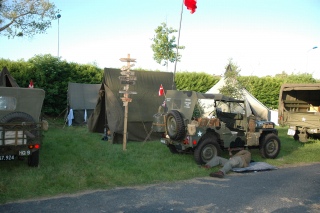 to buy a new releaser arm. After a short drive we found their location and was happy to note that they had not just one, but two releaser arms at a bargain price. I bought them both and borrowed a grinder in a garage next to their camp so I could adjust the head of the releaser arm so it was less wide as I thought it could have difficulty getting down without any problems. So I made it a little narrower ... just for safety's sake ... The mechanic could not speak a word in English .. so by the use of my 4 French-words vocabulary (Oui, Merci, Tres bien) I got it fixed and also bought some oil for our Chevrolet. It was a "Big Mechanic Day" back in the camp as we were soon to be on our way home and had to make our vehicles ready for the journey back home .... to buy a new releaser arm. After a short drive we found their location and was happy to note that they had not just one, but two releaser arms at a bargain price. I bought them both and borrowed a grinder in a garage next to their camp so I could adjust the head of the releaser arm so it was less wide as I thought it could have difficulty getting down without any problems. So I made it a little narrower ... just for safety's sake ... The mechanic could not speak a word in English .. so by the use of my 4 French-words vocabulary (Oui, Merci, Tres bien) I got it fixed and also bought some oil for our Chevrolet. It was a "Big Mechanic Day" back in the camp as we were soon to be on our way home and had to make our vehicles ready for the journey back home ....
Back in the camp, Erik and me began to perform the “operation” of getting the releaser arm attached to the clutch wheel and the cable.
Long live small and flexible hands and fingers!! After much cursing and swearing succeeded finally and we got it all installed .... and it worked really really well and even better than before. Both firmer and more stable ... The Jeep had apparently been driving with a releaser arm being "under liquidation" during the trip and even a field repair was completed with the pig stopped fingers as a result. (After this exercise I am now able to paint walls and ceiling in any room ...... through the keyhole of the door!)
We were again reminded of how tough these green vehicles are and how they toil loyal to us in all kinds of adversity .. and often against all odds.After this treatment the old trustworthy Jeep did very well during the entire trip home without problems.

This was just some of the challenges my Jeep brought me during the trip, but there were other vehicles facing technical problems "en route" to and from Normandy. Such as the Chevrolet, in which the fan broke loose due to a too tight and unflexibel fan belt, thereby cutting a hole into the cooler so that it lost all water instantly. It then had to be pulled all the way home with both the hustle and bustle and lack of sleep ... This happened after the GMC pulled off the bumper of the Chevrolet because of a loose drawbar. Then it was partly Sørens and later Franks Dodge who had to pull it by our thickest rope, which, incidentally broke repeatedly along the way. (Later, it has further been found that the exhaust cover had placed itself firmly on to the manifold, despite ongoing repairs underway, and was broken 3 places). And then there was Franks Dodge that “lost its breath” because of a clogged carburetor. And not to forget Oles GMC, which suddenly threw brake fluid .. All these incidents were also repaired along the way.
 Yes, I could get by with many other small technical anectdotes ... and what, for many, would be a stress factor of the greats, was done quietly and in good cooperation, helpfulness, and sedately cooperate on solutions to technical problems. All vehicles came safely home, either under its own power or by being pulled. Yes, I could get by with many other small technical anectdotes ... and what, for many, would be a stress factor of the greats, was done quietly and in good cooperation, helpfulness, and sedately cooperate on solutions to technical problems. All vehicles came safely home, either under its own power or by being pulled.
An eventful trip with many big and small experiences that can not be described in detail in this already too long, article ... The many cozy hours in the old army tent, can not be described in words ... The warm summer evenings were spent on preparing healthy and nutritious field food on the, on-meter-in-diameter, large cast iron pan, while there were tastings of rare whiskies while some very amusing tall tales were told .... one more obscene than the other ... And then there was the evening when Søren, dressed up in his Highland Kilt, was almost kidnapped by some Italians, after they had been drinking too much moonshine and could not resist to have a look what was below the Kilt… After some discussion, they were allowed to have a peek whereafter we finally could get Søren back home safely in our own camp ... We should perhaps mention that he in honor of the occasion was wearing skin-colored undies.
2014 is time for the next expedition and the preparation has begun... long time ago. Normandy, here we come.... we can not wait.
“See you at the Beach – Boys”
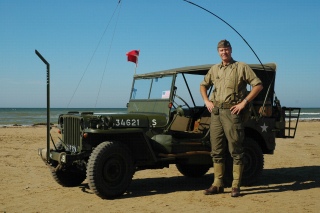

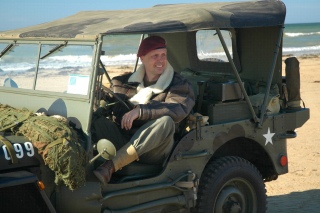


Back to other articles
|